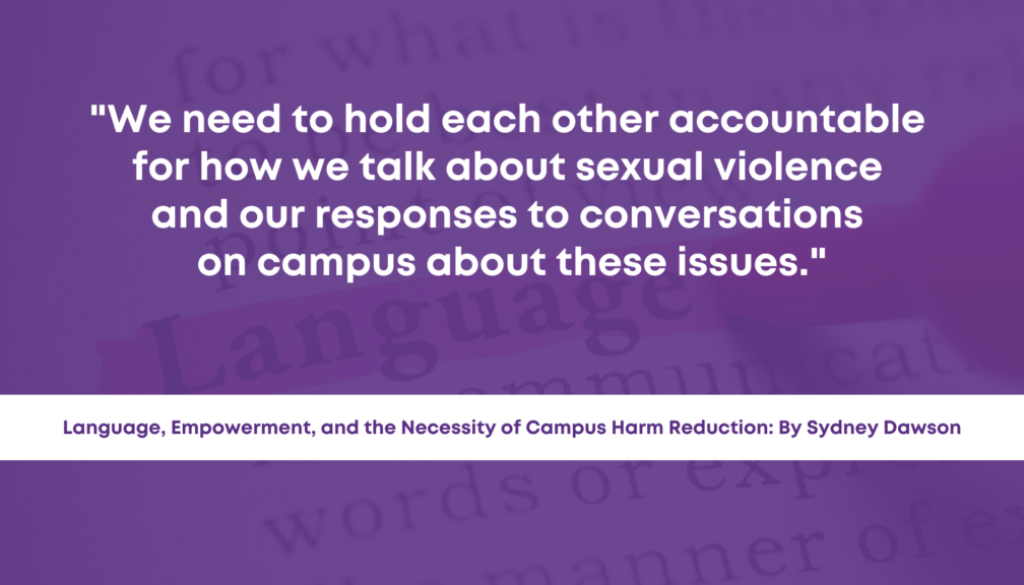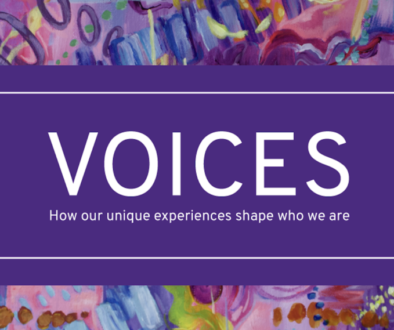Language, Empowerment, and the Necessity of Campus Harm Reduction
“Girl, you got this. You are strong, you are smart. Feel empowered to resist sexual violence. Come to the workshop!” I saw this poster in the UCC in March of 2020, shortly before Western shifted to online learning in response to the COVID-19 pandemic. It struck me in multiple ways; as a reader, as a feminist, as an anti-violence worker, and as a linguistic anthropology student. Language can be a looking glass into culture and social values and can play an important role in influencing the way we see the world around us. It is an element of conversations around sexual violence that is, in my opinion, often overlooked. The poster advertised an upcoming workshop meant to “increase your confidence and skill to resist sexual assault,” and I felt that it spoke to the larger cultural attitudes I have experienced and witnessed towards rape culture—particularly on Western’s campus.
While there is a lot to say about the linguistic functions of the poster (the implication that strong and smart people don’t get assaulted, that feeling empowered will help people “resist” a systemic violence, or that if we were more “confident,” sexual violence just wouldn’t happen to us), my relationship with it goes deeper than just a picture snapped in the UCC. I shared a (now-deleted) photo of the poster to the 31.5k-strong “Must Knows” for courses at UWO Facebook page expressing that I understood the purpose of the workshop but wondered if the poster could be critically examined in conversation with campus rape culture; this was met with a surprising amount of backlash. Several group members ‘laughed’ at the post, followed by comments to the tune of “is having a lock on my door also considered victim blaming?! It makes me feel empowered against thieves,” “This is ridiculous now. You think teaching people how to protect themselves is wrong now? Some next level bs.” One member called the poster’s removal an “irrational sjw win” (social justice warrior), while others relied on logical fallacies like anecdotes or ad hominem approaches. Many comments spoke to the unfortunate misrepresentation of the workshop’s functional intention and personal views on self-empowerment. Still, the increasingly hostile discussions in the threads below the post represented something significant. While the poster inspired divided opinions about victim-blaming, poor wording, and paternalism, it reflected a more profound sentiment about gender-based sexualized violence (GBSV) in Western’s student body and reflected common misunderstandings about harm reduction from multiple perspectives.
As a frontline harm reduction worker, I am well-acquainted with the sometimes controversial but upstream approach that harm reduction can offer, as well as the misconceptions that surround it. Sexual violence harm reduction is a particularly complicated topic because of its possibility to be confused for (or even morph into) victim-blaming. But, harm reduction is meant to use micro and case-to-case solutions to help combat macro problems. It does not assign responsibility to individuals for the harm or victimization they experience but acknowledges that we all (and intersectionally) operate within larger contexts and structures that can’t be dismantled overnight; steps need to be taken to empower people and reduce harm in the meantime. Corey (2019) describes it as “a melding of public health principles that seek to promote autonomy, empowerment, and social connectedness. Harm Reduction accepts individuals for who they are, and prevents those at greatest risk from experiencing the greatest harms.” So, in the same way that safe supply and injection sites might reduce harm in the face of drug crises or mental health epidemics, things like self-defence, education, and drug-spiking identification tools can help minimize harm while we work collectively to address the larger cultural conditions of rape culture, patriarchy, misogyny, and racism that contribute to the prevalence of GBSV. Harm reduction is a small piece in a bigger puzzle of change. Importantly, language can be a crucial tool for articulating the difference between victim blaming and mitigating harm in these conversations. The way we talk about these issues can be the difference between offering self-defence training to help others feel empowered and insinuating that not having that skill makes you (at least partially) responsible for someone else’s choice to hurt you.
Western’s response to recent acts of GBSV hasn’t yet reached what I would call effective harm reduction—increased police presence is an exceptionally unfavourable point given the complicated relationship many victims/survivors feel with law enforcement. We already know that Western’s rates of campus violence are the highest in Ontario (Government of Ontario, 2018; Ontario’s Universities, 2020; Yu, 2020), and that for a myriad of reasons, victims/survivors of violence don’t proportionately report their assaults to the police (Government of Canada & Department of Justice Canada, 2019; Howard, 2021). As students have been rightly pointing out, these facts don’t intuitively connect with increased police presence and, in fact, reflect a downstream approach that prioritizes addressing sexual violence after it has already happened. I believe that Western needs to shift their focus towards harm reduction rather than harm reaction; by the time we implement things like increased campus policing, the damage it is meant to address has often already been done. And, approaches which push often under-staffed and difficult-to-navigate GBSV and mental health services might ultimately contribute to harm for students struggling with life-changing experiences of violence during high-pressure post-secondary years. Measures like better GBSV education—including for bystanders—are an essential element of improving our campus approach. Other tactics like adjusted offender risk-identification strategies, drug-testing materials for drinks, institutional transparency, and better training about consent could be elements of a harm-reduction-based approach (Burczycka & Statistics Canada, 2020).
It is nice to see that the USC has made efforts to incorporate harm reduction into their anti-GBSV programming in recent weeks, and it shows (from where I stand) some growth in the effectiveness of harm reduction competency on campus. However, while a poster can be taken down, and student government approaches to GBSV can adapt, a true harm-reduction approach has to recognize that the underlying problem on Western’s campus is the insidious ways that rape culture permeates the student body and campus attitudes. Indicators for these attitudes aren’t always glaring and loud; sometimes, they slip past a copywriter, a graphic designer, and a workshop team. Other times, they creep into the comments of posts and use alarmist tactics to distract from the issue at hand, like those that told reductive tales of de-sophing without due process on the whim of spiteful female students. I’m by no means intending to say that people who disagreed with my interpretation of the poster are wrong, misogynistic, or even violent. What I am saying is that better implementation of harm reduction (and the language we use to facilitate it) could have mitigated comments about victims/survivors’ processual privilege or how the responsibility for preventing rape lies in the hands of victims/survivors who should have simply ‘locked their doors’ in the first place.
I can understand feedback that my critique of the poster may be pedantic or too focused on the semantics of the wording rather than the workshop itself. Still, I think what can be taken away from this example is that language reflects our attitudes towards issues in profound ways we might not intend or even be aware of. Both the poster itself and the online response spoke loud and clear: Western has a rape culture issue, and it can’t even be addressed without replicating itself. Only time will tell if newly proposed measures such as mandatory residence sexual violence education or increased police presence will effectively combat rape culture at Western. In the meantime, we need to hold each other accountable for how we talk about sexual violence and our responses to conversations on campus about these issues. We can start small, by speaking up when we see someone engaging in victim-blaming, rape apology, or violence, and we must keep practicing reflexivity; there’s nothing wrong with recognizing a harmful attitude or behaviour in ourselves and using that information to treat the people around us more compassionately. In fact, it’s an essential piece of harm reduction strategy that I hope the Western community will see more of in the future.

References
Burczycka, M., & Statistics Canada. (2020, September 14). Students’ experiences of unwanted sexualized behaviours and sexual assault at postsecondary schools in the Canadian provinces, 2019. Statcan.gc.ca; Government of Canada, Statistics Canada. https://www150.statcan.gc.ca/n1/pub/85-002-x/2020001/article/00005-eng.htm
Government of Ontario. (2018). Student Voices on Sexual Violence. Ontario.ca. https://www.ontario.ca/page/student-voices-sexual-violence
Government of Canada, & Department of Justice Canada. (2019). JustFacts – Sexual Assault. Justice.gc.ca. https://www.justice.gc.ca/eng/rp-pr/jr/jf-pf/2019/apr01.html
Howard, J. (2021, June 9). Sexual Assault And Harassment in Canada | The Facts. Canadian Women’s Foundation. https://canadianwomen.org/the-facts/sexual-assault-harassment/
Ontario’s Universities. (2020, February 28). Student Voices on Sexual Violence Climate Survey – Ontario’s Universities. Ontario’s Universities. https://ontariosuniversities.ca/student-voices-on-sexual-violence-survey
Westside Harm Reduction, & Corey. (2019, November 18). Westside Harm Reduction. Westside Harm Reduction. https://www.westsideharmreduction.com/news-notes/westside-harm-reduction
Western USC. (2021, October 20). Together for Change – Western USC. Western USC. https://westernusc.ca/together-for-change/
Yu, A. (2020, March 10). More than 70 per cent of Western University students report being sexually harassed. CBC. https://www.cbc.ca/news/canada/london/western-university-sexual-assault-harassment-statistics-survey-1.5488041




